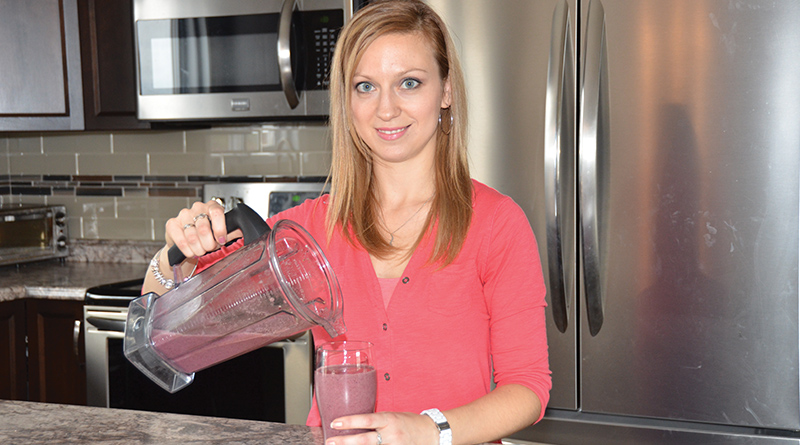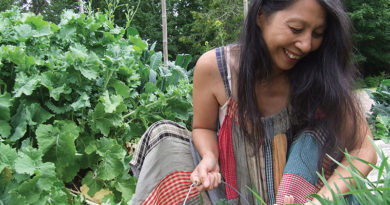Overcoming Raynaud’s
By Sari Huhtala
Having never given much thought to food intolerances, Melanie Simon had come to the resolve in her teenage years that lack of energy and daily headaches, along with severe eczema, was just part of her genetic make-up. But when, in her early 20s, symptoms like debilitating inflammation of her toes and lack of circulation surfaced, she knew something had drastically changed. “Something was seriously wrong,” Simon, a Greater Sudbury resident says.
“My toes were actually going purple and black. At first I thought it was frostbite, but three winters in a row the tips of my toes would be inflamed and purple.” She was 22 when she first went to visit her doctor, concerned over the symptoms. “When the doctor said “I think you have Rayanud’s” it shook me to the core.
I have two young kids and I want to be around for them for a long time.” Once vascular studies and tests confirmed it was in fact Raynaud’s disease, an autoimmune condition that causes decreased blood circulation to some areas of the body, like fingers and toes, and results in numbness in response to cold temperatures, the doctor’s recommended course of action was pharmaceuticals to manage the symptoms.
The doctor immediately wanted to place her on channel blockers – a high blood pressure medication that she would likely have to rely on for the rest of her life. “I refused to go on the medication,” Simon says. “I just felt obviously there had to be something else I could do. Medication would be my last resort.” She had immediately quit smoking, recognizing that it likely exacerbated the symptoms, and then set on a path to determine how she would naturally manage life with Raynaud’s.
In researching natural alternatives for Raynaud’s she came across recommendations to eliminate caffeine and alcohol, which can trigger symptoms, as well as eliminating processed foods, and eating a natural whole food diet. Increasing cardiovascular exercise is also essential as it plays a role in increasing blood circulation, she adds. “I wanted to figure out what was causing me to have all of these issues and I didn’t stop until I figured it out.”
Although now, at the age of 28, she has completely revamped her dietary habits and swapped out all ingredients from her pantry for truly healthy options, the change didn’t happen overnight, she says. For Simon, taking a nutritional approach to heal would require a complete remodelling of her culinary skills. What she once defined as a home-cooked meal – meat and veggies alongside of an out-of-the-packet Sidekicks® pasta – took on a whole new meaning.
“I did cook, but most of what I made wasn’t from scratch. I had the assumption it was a fairly healthy choice,” Simon says. “I don’t understand why nutrition and cooking is not taught in school. It’s ridiculous. They are so keen on teaching algebra, but how would that matter if you’re dying of heart disease; if you don’t have your health? “I researched recipes. It wasn’t something that happened overnight.
It takes a long time to change the way you’ve been eating. I learned how to read labels. I would look at the ingredients and if I didn’t know what the ingredient was then I’d Google it. Over time you start to remember which ingredients you want to avoid.” She began to slowly replace the not-so-healthy items in her pantry with healthy options. When she ran out of a condiments or staples like white rice she’d replace them with “only the healthy stuff.”
Sensing positive changes in her wellbeing, and with Raynaud’s symptoms diminishing, this newfound way of approaching health from a nutritional standpoint spurred her on to study to become a registered holistic nutritionist. In delving deeper into the role dietary choices and nutrition play in chronic disease and illness, the mystery of why she had experienced so many headaches, fatigue and eczema throughout her youth began to unravel. After embarking on an elimination diet, she discovered she couldn’t tolerate gluten or dairy.
“When I cut gluten and dairy out of my diet it made a huge difference,” Simon says. “A lot of the problems I had were related to my food intake. When I cut out dairy and gluten the spot of eczema that I had on my hand for three years went away on its own in one month and it’s never come back. That showed me that something was healing from the inside.” She began taking quality probiotics and has continued taking them every day for the last three years. “Oftentimes an autoimmune disease can be linked to food intolerances.
If you’re still eating foods that you are intolerant to then it can aggravate symptoms.” The first place to look for food intolerances is in the foods that you feel you can’t live without, she says. In her case, giving up her addiction to cheese was initially a tough one. “Think about what food you feel you can’t live without,” Simon says. “Whatever your answer is, is your starting point.” “For myself, I think (Raynaud’s came as a result of) eating the foods I was intolerant to, which caused leaky gut syndrome and leaky gut syndrome has been linked to so many autoimmune diseases, so I think that was my problem all along.”
Throughout her childhood, she says she remembers complaining a lot about headaches and stomach aches, and growing pains, and was eventually diagnosed as having abdominal migraines, which basically presents as stomach aches without head pain. It took about one and a half years for her body to heal once she started her journey.
“I just felt that I was going to do everything I can to be the healthiest I can be for my family.” The nice natural side effect of her choice has been healthier kids, and the laying of a good foundation for them for their future health.




